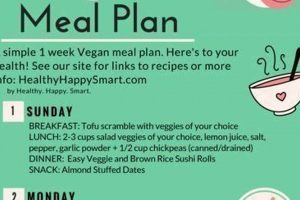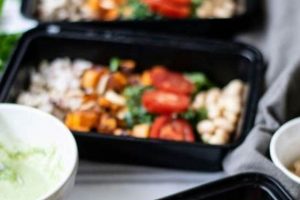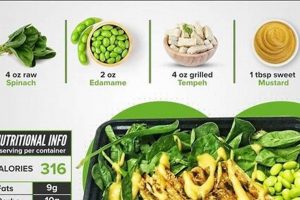Food prepared without animal products that is simple and quick to make while in an outdoor, temporary living situation constitutes a specific category of meal preparation. Examples include lentil stews cooked over a portable stove, pre-chopped vegetable skewers grilled on a campfire, or instant oatmeal enhanced with dried fruit and nuts.
The significance of this culinary approach lies in its ethical considerations, environmental benefits, and health advantages. Moreover, it offers a lightweight and non-perishable food solution for individuals engaging in outdoor activities. Historically, reliance on plant-based staples has been essential for travelers and explorers due to limited preservation capabilities.
The following sections will detail the practical considerations for crafting nutritious and palatable meals in this setting. This includes strategies for meal planning, selecting appropriate ingredients, and utilizing efficient cooking techniques to maximize convenience and minimize environmental impact.
Strategies for Streamlined Plant-Based Campsite Dining
Effective preparation is paramount for successful plant-based campsite dining. The following recommendations aim to optimize the experience by focusing on simplicity, nutritional value, and minimal environmental impact.
Tip 1: Prioritize Meal Planning: Develop a detailed menu for the duration of the trip. This minimizes spontaneous food purchases and ensures adequate nutritional intake. Consider portion sizes to prevent food waste.
Tip 2: Dehydrate or Dry Ingredients: Removing moisture from fruits, vegetables, and legumes reduces weight and extends shelf life. A food dehydrator is recommended, though sun-drying is an alternative method in appropriate climates.
Tip 3: Select Non-Perishable Staples: Grains such as quinoa, rice, and couscous, as well as dried legumes and nuts, offer stable and nutrient-rich options that do not require refrigeration. These can form the base of numerous meals.
Tip 4: Invest in Efficient Cooking Equipment: A lightweight, portable stove with adjustable flame control facilitates controlled cooking. Multi-functional cookware reduces the number of items needed, saving space and weight.
Tip 5: Pre-Chop and Prepare Ingredients: Laborious tasks such as chopping vegetables can be completed at home, reducing preparation time at the campsite. Store prepped ingredients in airtight containers.
Tip 6: Utilize Versatile Seasonings: Carry a small selection of seasonings such as salt, pepper, garlic powder, and chili flakes. These enhance the flavor of various dishes without adding significant weight.
Tip 7: Pack Reusable Containers and Utensils: Minimize waste by using durable, reusable containers and utensils. Opt for lightweight materials such as bamboo or stainless steel.
Adherence to these suggestions fosters a more efficient and enjoyable plant-based campsite dining experience. Emphasis on preparation and appropriate equipment contributes to reduced environmental impact and optimized nutritional intake.
The subsequent section will address specific plant-based recipes suitable for campsite preparation, providing practical examples of the strategies outlined above.
1. Minimalist Ingredient Selection
Minimalist ingredient selection is a critical factor in simplifying the creation of plant-based meals during camping excursions. By strategically limiting and optimizing the ingredients chosen, logistical burdens are reduced, nutritional needs are met, and overall efficiency is enhanced.
- Reduced Pack Weight
Each ingredient contributes to the overall weight carried. A minimalist approach focuses on multi-purpose items and dehydrated or lightweight options. For instance, a single spice blend can replace multiple individual spices, or dehydrated vegetables can substitute fresh ones to reduce weight without sacrificing nutritional value.
- Simplified Meal Planning
A restricted palette of ingredients encourages creative combinations and reduces the complexity of menu planning. Pre-planning meals around a few core ingredients streamlines the shopping process and reduces the likelihood of forgetting essential items. An example is building several meals around a base of quinoa, incorporating different vegetables and seasonings for variety.
- Minimized Waste and Spoilage
Fewer ingredients translate to less potential for unused portions and subsequent waste. Selecting non-perishable items or using precise portioning techniques minimizes the risk of spoilage, particularly crucial in the absence of refrigeration. Examples include relying on dried legumes rather than canned, and pre-measuring quantities needed for each meal.
- Increased Efficiency in Preparation
Limiting the number of ingredients streamlines the cooking process. Fewer items to chop, measure, and combine saves time and effort at the campsite, allowing for more time spent enjoying the outdoor environment. An example is utilizing pre-chopped and dehydrated vegetables that require minimal preparation before cooking.
By adopting a minimalist approach to ingredient selection, the complexities associated with preparing plant-based cuisine in a camping context are significantly reduced. This not only makes meal preparation more manageable but also contributes to a more sustainable and enjoyable outdoor experience.
2. Simplified Cooking Methods
The effectiveness of generating plant-based meals in a camping environment is significantly impacted by the adoption of simplified cooking techniques. Complex culinary processes are often impractical in outdoor settings; therefore, streamlined approaches are necessary to facilitate efficient and nutritious food preparation.
- One-Pot Meals
The consolidation of all ingredients into a single cooking vessel minimizes cleanup and reduces the amount of equipment needed. Examples include lentil stews, chili, and pasta dishes. This method is particularly suited for campsites with limited water resources, as it reduces the need for washing multiple pots and pans.
- Foil Packet Cooking
Wrapping ingredients in aluminum foil and placing them directly on hot embers allows for even cooking with minimal monitoring. Vegetables, plant-based protein sources, and seasonings can be combined in a packet for a self-contained meal. This method also prevents food from sticking and burning, which is beneficial when cooking over an open fire.
- No-Cook Options
Certain ingredients require no cooking at all, providing a quick and convenient meal solution. Options such as pre-made hummus wraps, overnight oats, and salads with pre-cooked grains eliminate the need for a heat source, reducing reliance on fuel and simplifying the cooking process. These methods are especially useful during periods of extreme weather conditions or when fire restrictions are in place.
- Pre-Soaked Ingredients
Soaking grains and legumes before camping reduces cooking time and fuel consumption. Quinoa, oats, and lentils can be soaked overnight or for several hours, significantly shortening the time required to cook them at the campsite. This approach also improves the digestibility of some legumes, mitigating potential digestive issues.
The implementation of these simplified cooking methods significantly enhances the feasibility of creating plant-based meals while camping. These streamlined techniques maximize efficiency, minimize resource consumption, and ensure that nutritious food can be readily prepared in outdoor environments. These approaches directly support the ease and practicality associated with generating edible, ethically aligned sustenance in temporary outdoor living scenarios.
3. Lightweight Food Packaging
The practicality of preparing plant-based meals in a camping context is significantly enhanced through the implementation of lightweight food packaging. The inverse relationship between pack weight and mobility dictates that lighter packaging directly contributes to ease of transport. This principle is of particular importance in remote locations, where minimizing physical strain is crucial. Traditional glass or heavy plastic containers are often replaced with alternatives that offer substantial weight savings, such as resealable mylar bags or silicone containers. Dehydrated meals, a staple of plant-based camping cuisine, are frequently packaged in such materials, further reducing both weight and volume. This allows for the efficient carriage of multiple meals without exceeding weight limitations.
The selection of appropriate lightweight packaging also impacts waste management practices. Reusable silicone bags and containers not only minimize weight but also reduce the environmental impact associated with single-use plastics. Vacuum-sealed pouches offer extended shelf life for certain ingredients, reducing the likelihood of food spoilage and waste. Careful consideration must be given to the durability of the packaging, ensuring it can withstand the rigors of outdoor travel and storage. Compromises between weight and durability are frequently necessary, with preference given to materials that offer the best balance of both attributes. For example, while a plastic bag may be the lightest option, a reinforced reusable container offers better protection against crushing and tearing, potentially preventing food loss and the generation of litter.
In conclusion, lightweight food packaging is an indispensable component of successfully executing plant-based sustenance in the outdoors. Its implementation directly reduces pack weight, facilitates efficient transportation, and can minimize environmental impact. Challenges remain in balancing weight reduction with durability and cost, but the benefits in terms of mobility and sustainability make it an essential consideration for any camping trip. The selection of appropriate materials and packaging methods is therefore integral to the overall success of the camping experience.
4. Efficient Meal Pre-Planning
Effective pre-planning is fundamental to the successful execution of plant-based sustenance during temporary outdoor living scenarios. This preparatory phase directly influences the ease and efficiency of meal preparation at the campsite, mitigating potential logistical challenges associated with cooking in remote environments. A detailed pre-planning strategy ensures nutritional needs are met while minimizing the resources and time required for meal preparation.
- Menu Development and Recipe Selection
Menu development involves creating a comprehensive meal plan for the duration of the camping trip. This includes selecting recipes that align with dietary requirements, available cooking equipment, and the expected duration of the outing. Prioritizing recipes with overlapping ingredients reduces the overall number of items required, streamlining the packing process. Real-world examples include planning breakfasts of overnight oats and dinners of dehydrated lentil soup, both requiring minimal on-site preparation. This careful selection optimizes the allocation of resources, particularly fuel and water.
- Ingredient Procurement and Portioning
Ingredient procurement entails purchasing the necessary food items in advance and portioning them appropriately. This minimizes the risk of running out of essential ingredients or carrying excessive quantities. Pre-portioning ingredients into individual bags or containers facilitates streamlined meal assembly at the campsite and reduces the potential for food waste. As an illustration, dried legumes and grains can be pre-measured into sealed bags, simplifying the cooking process and eliminating the need for measuring tools in the field. This systematic approach ensures adherence to dietary requirements and optimizes resource utilization.
- Dehydration and Pre-Cooking
Dehydration and pre-cooking represent critical components of pre-planning. Dehydrating fresh vegetables or fruits significantly reduces weight and extends shelf life, making them ideal for camping trips. Pre-cooking grains or legumes, such as quinoa or lentils, can substantially shorten cooking times at the campsite. Practical examples include dehydrating sliced apples for snacks or pre-cooking quinoa to be added to salads. These techniques decrease the reliance on cooking equipment and fuel, streamlining the meal preparation process.
- Packaging and Labeling
Proper packaging and labeling are essential for efficient organization and retrieval of ingredients. Utilizing lightweight, resealable bags or containers helps to minimize weight and prevent spills. Clearly labeling each package with the contents and intended meal facilitates quick identification and reduces the risk of errors during preparation. For example, labeling bags of dehydrated vegetables with the corresponding recipe name ensures that the correct ingredients are used for each meal. This attention to detail minimizes confusion and promotes efficient meal preparation.
In summation, efficient meal pre-planning forms the cornerstone of achieving “easy vegan camping meals”. The interconnectedness of menu development, ingredient procurement, dehydration techniques, and thoughtful packaging directly affects the ease and efficiency with which plant-based sustenance can be prepared in outdoor environments. A comprehensive approach to pre-planning ensures nutritional needs are met, resources are used judiciously, and the overall camping experience is enhanced.
5. Nutritional Completeness
Attaining nutritional completeness within the context of simplified plant-based meal preparation during temporary outdoor living is paramount for sustaining physiological well-being. Inadequate nutrient intake can lead to diminished energy levels, impaired cognitive function, and compromised immune response, thereby detracting from the overall camping experience. Because resources and preparation time are limited, ensuring that meals provide sufficient macro- and micronutrients becomes a critical challenge. Real-world examples of the consequences of neglect include developing fatigue during strenuous activities or experiencing digestive discomfort due to inadequate fiber intake. Understanding this connection is essential for individuals undertaking extended outdoor expeditions.
The practical application of nutritional completeness considerations requires a strategic approach to meal planning and ingredient selection. Emphasis should be placed on incorporating a diverse array of plant-based foods to meet requirements for protein, carbohydrates, fats, vitamins, and minerals. For example, incorporating fortified nutritional yeast into meals provides a source of vitamin B12, a nutrient often lacking in plant-based diets. Additionally, combining legumes with grains ensures a complete protein profile. Another practical consideration involves adequate hydration, which is crucial for nutrient absorption and overall physiological function, but can be readily overlooked in the absence of readily accessible water sources. Attention to these practical details supports optimized physical performance and prevents nutritional deficiencies.
In conclusion, achieving nutritional completeness is not merely an adjunct to simplified plant-based sustenance during temporary outdoor living scenarios, but a fundamental element for maintaining optimal health and performance. While the constraints of limited resources and preparation time pose challenges, a strategic approach to meal planning and ingredient selection enables the creation of nutritionally adequate, simplified plant-based meals. Integrating these considerations into the camping experience promotes physical resilience, ensures sustained energy levels, and contributes to an overall enhancement of well-being. Overlooking nutritional completeness diminishes the positive outcomes of outdoor recreation.
Frequently Asked Questions Regarding Efficient Plant-Based Sustenance During Temporary Outdoor Living
The following section addresses common inquiries pertaining to the preparation and execution of straightforward vegan meals in camping environments. These questions aim to clarify best practices and mitigate potential challenges encountered during this process.
Question 1: Is specialized equipment necessary for the preparation of plant-based meals in a camping environment?
Specialized equipment is not a strict prerequisite. However, certain items can significantly enhance efficiency. A portable stove facilitates controlled cooking, while lightweight cookware minimizes pack weight. A water filter is essential for accessing potable water sources. While optional, these items contribute to a more streamlined and convenient meal preparation process.
Question 2: How can nutritional adequacy be assured when resources and preparation time are limited?
Nutritional adequacy can be addressed through careful meal planning and ingredient selection. Prioritizing nutrient-dense foods, such as legumes, grains, and fortified nutritional yeast, ensures adequate protein, vitamins, and minerals. Pre-planning meals and portioning ingredients minimizes the risk of nutrient deficiencies.
Question 3: What strategies mitigate the risk of food spoilage in the absence of refrigeration?
The risk of food spoilage can be minimized through several techniques. Selecting non-perishable items, dehydrating fresh produce, and properly storing ingredients in airtight containers are effective measures. Adhering to food safety guidelines and consuming perishable items within a reasonable timeframe also helps prevent spoilage.
Question 4: What are the environmental considerations associated with plant-based campsite dining?
Environmental considerations encompass minimizing waste and practicing Leave No Trace principles. Utilizing reusable containers and utensils, packing out all trash, and avoiding open fires when possible are environmentally responsible practices. Choosing locally sourced and sustainably produced ingredients further reduces the environmental footprint.
Question 5: How can the weight of food supplies be minimized for extended camping trips?
Minimizing weight involves selecting lightweight and compact ingredients. Dehydrated foods, freeze-dried meals, and concentrated powders offer significant weight savings. Packing items in reusable, lightweight containers and carefully calculating portion sizes further reduces the overall weight of food supplies.
Question 6: What are the ethical considerations associated with choosing plant-based meals in an outdoor environment?
Ethical considerations primarily involve minimizing the impact on local ecosystems and wildlife. Avoiding the consumption of animal products reduces demand for resources associated with animal agriculture. Practicing responsible waste disposal and minimizing disturbance to the natural environment are crucial aspects of ethical campsite dining.
The preceding responses provide guidance on addressing common concerns and misconceptions related to plant-based sustenance in outdoor settings. Prioritizing careful planning, resource management, and ethical considerations contributes to a more enjoyable and responsible camping experience.
The following section will provide a set of sample menus, offering a practical guide for constructing your own plant-based camping meals.
Conclusion
This exploration of straightforward plant-based meal preparation in temporary outdoor scenarios has underscored the importance of meticulous planning, appropriate resource management, and a commitment to minimizing environmental impact. The principles of minimalist ingredient selection, simplified cooking methods, lightweight packaging, efficient meal pre-planning, and attentiveness to nutritional completeness have been presented as essential components for successful implementation.
The capacity to craft nutritionally adequate and ethically aligned meals during outdoor activities requires careful consideration and adherence to these fundamental principles. While challenges persist in balancing resource constraints with nutritional needs, the commitment to simplified, plant-based sustenance offers significant benefits for both individual well-being and environmental stewardship. Future endeavors should prioritize innovative approaches to ingredient sourcing, sustainable packaging solutions, and accessible educational resources to further facilitate the adoption of this practice.







